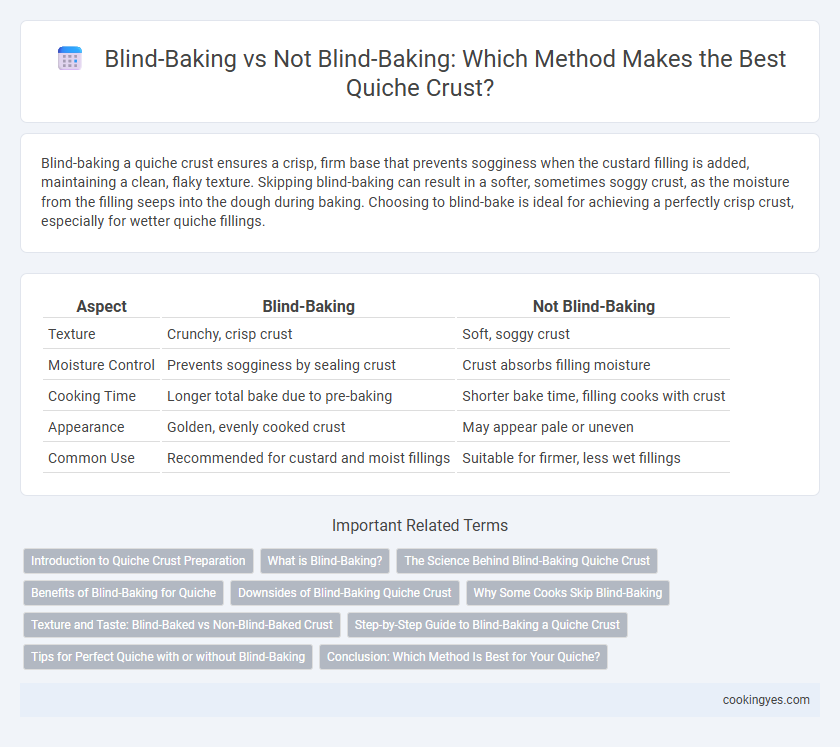Blind-baking a quiche crust ensures a crisp, firm base that prevents sogginess when the custard filling is added, maintaining a clean, flaky texture. Skipping blind-baking can result in a softer, sometimes soggy crust, as the moisture from the filling seeps into the dough during baking. Choosing to blind-bake is ideal for achieving a perfectly crisp crust, especially for wetter quiche fillings.
Table of Comparison
| Aspect | Blind-Baking | Not Blind-Baking |
|---|---|---|
| Texture | Crunchy, crisp crust | Soft, soggy crust |
| Moisture Control | Prevents sogginess by sealing crust | Crust absorbs filling moisture |
| Cooking Time | Longer total bake due to pre-baking | Shorter bake time, filling cooks with crust |
| Appearance | Golden, evenly cooked crust | May appear pale or uneven |
| Common Use | Recommended for custard and moist fillings | Suitable for firmer, less wet fillings |
Introduction to Quiche Crust Preparation
Blind-baking the quiche crust ensures a crisp, fully cooked base that prevents sogginess when filled with moist ingredients like eggs and cream. Skipping blind-baking can result in a softer, less structured crust that may not hold up well under the weight of the filling. Understanding the benefits of blind-baking enhances quiche crust texture and overall dish quality.
What is Blind-Baking?
Blind-baking is the process of pre-baking a quiche crust before adding the filling, ensuring a crisp, fully cooked base that prevents sogginess. This technique involves lining the crust with parchment paper or foil and filling it with pie weights or dried beans to maintain shape during baking. By blind-baking, the crust achieves a firm texture that supports the custard filling without becoming soggy or undercooked.
The Science Behind Blind-Baking Quiche Crust
Blind-baking quiche crust involves pre-baking the dough without filling to prevent sogginess caused by wet custard or moisture from vegetables. This technique uses heat to create a moisture barrier by partially cooking the starches and forming a seal, which ensures a crisp, golden crust. Skipping blind-baking often results in a softer, less structurally sound crust due to moisture absorption during baking, affecting texture and overall quiche quality.
Benefits of Blind-Baking for Quiche
Blind-baking a quiche crust prevents a soggy bottom by setting the pastry before adding wet fillings, ensuring a crisp and golden texture. This technique helps maintain the structural integrity of the crust, preventing it from becoming soggy or undercooked during the baking process. By blind-baking, the quiche achieves an ideal balance of flaky crust and creamy filling, enhancing both texture and flavor.
Downsides of Blind-Baking Quiche Crust
Blind-baking quiche crust can lead to over-drying and excessive browning, which negatively affects texture and flavor. The crust may also shrink during blind-baking, causing uneven edges and a compromised seal for the filling. Moreover, this process requires extra time and effort, making it less efficient for quick meal preparation.
Why Some Cooks Skip Blind-Baking
Some cooks skip blind-baking quiche crust to preserve a tender, flaky texture that can be lost during the pre-baking process. Skipping blind-baking reduces preparation time and avoids overcooking the crust, especially when using high-moisture fillings like quiche Lorraine. However, this method may risk a soggy bottom unless the filling is carefully balanced and baking temperature is properly controlled.
Texture and Taste: Blind-Baked vs Non-Blind-Baked Crust
Blind-baking a quiche crust results in a crisp, golden texture that prevents sogginess by fully cooking the dough before adding the filling. Non-blind-baked crusts often turn softer or slightly doughy as the filling's moisture seeps into the pastry during baking. Taste profiles vary as a blind-baked crust offers a toasted, buttery flavor contrasted with the moister, less complex taste of a non-blind-baked crust.
Step-by-Step Guide to Blind-Baking a Quiche Crust
Preheat the oven to 375degF (190degC) and line the quiche crust with parchment paper or aluminum foil, then fill with pie weights or dried beans to prevent bubbling. Bake the crust for 15 minutes, remove the weights and lining, and bake for an additional 5-7 minutes until the edges are lightly golden. This blind-baking process ensures a crisp, non-soggy crust, essential for quiche recipes with wet fillings.
Tips for Perfect Quiche with or without Blind-Baking
Blind-baking a quiche crust ensures a crisp, fully cooked base that prevents sogginess when filled with wet ingredients like custard and vegetables. For a flawless crust without blind-baking, use a higher oven temperature and drain excess moisture from fillings to maintain firmness and prevent a mushy bottom. Chilling the dough before baking and using pie weights during blind-baking can enhance crust texture and baking evenness for a perfect quiche.
Conclusion: Which Method Is Best for Your Quiche?
Blind-baking quiche crust ensures a crisp, fully cooked base that prevents sogginess from the custard filling, making it ideal for recipes with moist ingredients. Skipping blind-baking can save time but risks a less firm crust, often resulting in a softer, sometimes soggy texture. For the best quiche outcome, blind-baking is recommended to achieve a crisp, golden crust with optimal structural integrity.
Blind-baking vs not blind-baking for quiche crust Infographic

 cookingyes.com
cookingyes.com